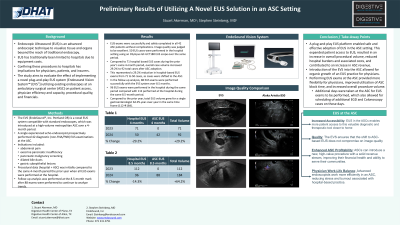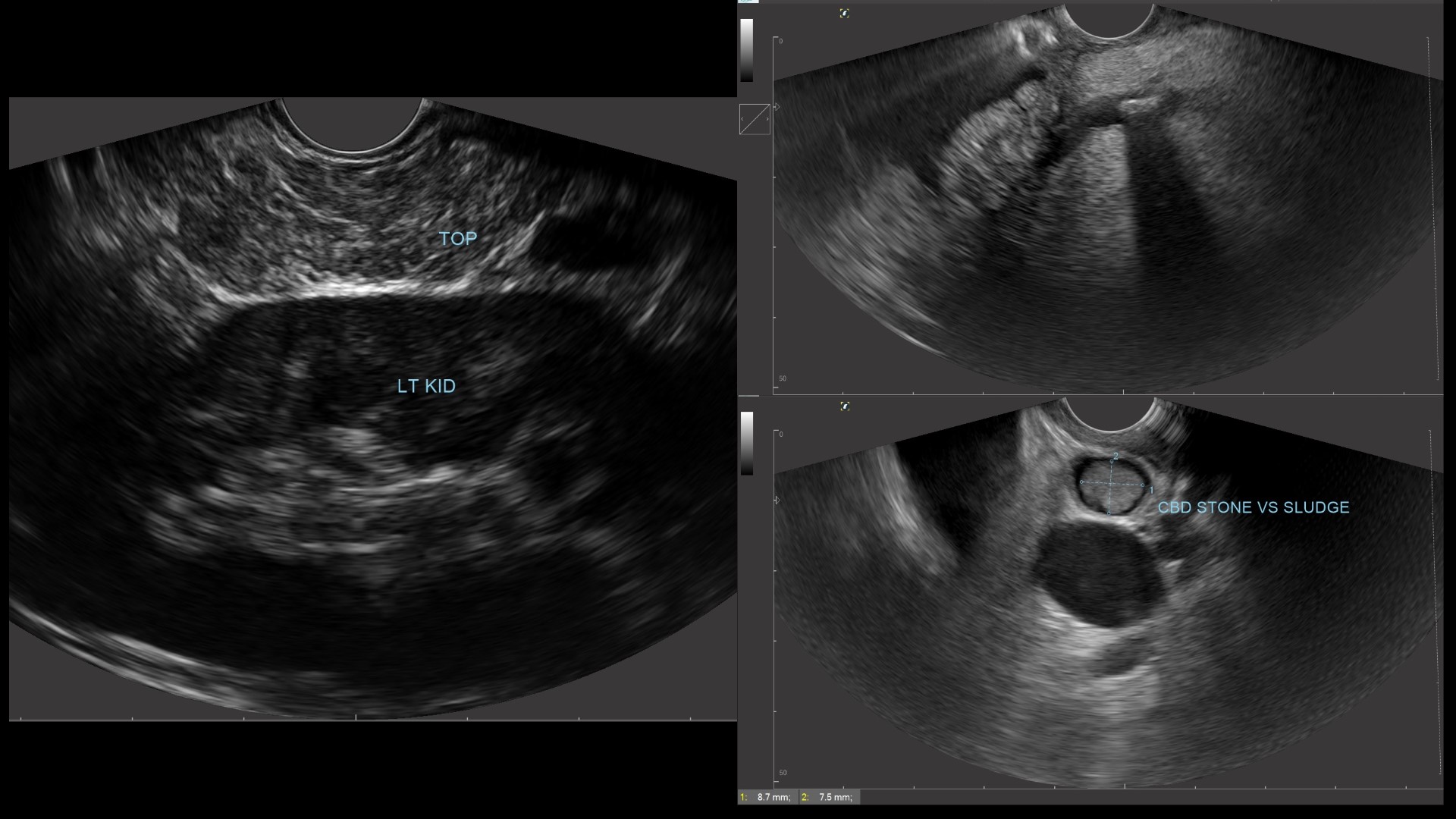Monday Poster Session
Category: Interventional Endoscopy
P2778 - Preliminary Results of Utilizing A Novel EUS Solution in an ASC Setting
Monday, October 28, 2024
10:30 AM - 4:00 PM ET
Location: Exhibit Hall E

Has Audio
- SS
Stephen E. Steinberg, MD
EndoSound, Inc.
Boca Raton, FL
Presenting Author(s)
Stuart Akerman, MD1, Stephen E. Steinberg, MD2
1Digestive Health Associates of Texas, Dallas, TX; 2EndoSound, Inc., Boca Raton, FL
Introduction: Endoscopic ultrasound (EUS) is an advanced endoscopic technique with growing clinical applications. EUS has traditionally been confined to hospital settings due to costly equipment requirements. Limiting EUS to hospital units increases costs and logistical challenges for patients and physicians. The aim of this study is to evaluate the effect of implementing a novel plug-and-play EUS hardware system utilizing existing endoscopes at an ambulatory surgical center (ASC) on patient access, physician efficiency and capacity, procedural quality, and financials.
Methods: The EndoSound EVS (EndoSound, Inc. Portland OR), a novel EUS system compatible with standard endoscopes, was introduced at a high-volume metropolitan ASC over a 4-month period. A single experienced echo-endoscopist prospectively performed 42 diagnostic (non-FNA/FNB) EUS examinations at the ASC. Indications included abdominal pain, exocrine pancreatic insufficiency, pancreatic malignancy screening, dilated bile ducts, and gastric submucosal lesions. Procedural data (hospital + ASC) was compared to the same 4-month period the prior year when all EUS exams were performed at the hospital.
Results: EUS exams were successfully and safely completed in all 42 ASC patients without complications. Image quality was judged to be excellent. Compared to 71 hospital based EUS cases during the prior year's 4-month period, overall case volume increased 29.58% to 92 total cases after ASC adoption. This represented a 29.58% reduction in hospital-based EUS exams from 71 to 50 cases, as cases were shifted to the ASC. For the operator, the result was a full day a month of procedures removed from the inefficiencies of the hospital to the ASC, and greater flexibility in scheduling. Very preliminary data from the initial cases suggest a favorable impact on revenue/profitability. The device has been awarded a transient pass-through exemption (TPT: "C code") by the Center for Medicare Services and while further implementation with this TPT code should make the value proposition even more attractive, this remains to be proven.
Discussion: Adopting a plug-and-play EUS platform enabled safe and effective ambulatory EUS in the ASC setting. This expanded patient access to EUS, resulted in an increase in overall procedural volume, reduced hospital burdens and associated costs, and an increase in ASC revenues.

Disclosures:
Stuart Akerman, MD1, Stephen E. Steinberg, MD2. P2778 - Preliminary Results of Utilizing A Novel EUS Solution in an ASC Setting, ACG 2024 Annual Scientific Meeting Abstracts. Philadelphia, PA: American College of Gastroenterology.
1Digestive Health Associates of Texas, Dallas, TX; 2EndoSound, Inc., Boca Raton, FL
Introduction: Endoscopic ultrasound (EUS) is an advanced endoscopic technique with growing clinical applications. EUS has traditionally been confined to hospital settings due to costly equipment requirements. Limiting EUS to hospital units increases costs and logistical challenges for patients and physicians. The aim of this study is to evaluate the effect of implementing a novel plug-and-play EUS hardware system utilizing existing endoscopes at an ambulatory surgical center (ASC) on patient access, physician efficiency and capacity, procedural quality, and financials.
Methods: The EndoSound EVS (EndoSound, Inc. Portland OR), a novel EUS system compatible with standard endoscopes, was introduced at a high-volume metropolitan ASC over a 4-month period. A single experienced echo-endoscopist prospectively performed 42 diagnostic (non-FNA/FNB) EUS examinations at the ASC. Indications included abdominal pain, exocrine pancreatic insufficiency, pancreatic malignancy screening, dilated bile ducts, and gastric submucosal lesions. Procedural data (hospital + ASC) was compared to the same 4-month period the prior year when all EUS exams were performed at the hospital.
Results: EUS exams were successfully and safely completed in all 42 ASC patients without complications. Image quality was judged to be excellent. Compared to 71 hospital based EUS cases during the prior year's 4-month period, overall case volume increased 29.58% to 92 total cases after ASC adoption. This represented a 29.58% reduction in hospital-based EUS exams from 71 to 50 cases, as cases were shifted to the ASC. For the operator, the result was a full day a month of procedures removed from the inefficiencies of the hospital to the ASC, and greater flexibility in scheduling. Very preliminary data from the initial cases suggest a favorable impact on revenue/profitability. The device has been awarded a transient pass-through exemption (TPT: "C code") by the Center for Medicare Services and while further implementation with this TPT code should make the value proposition even more attractive, this remains to be proven.
Discussion: Adopting a plug-and-play EUS platform enabled safe and effective ambulatory EUS in the ASC setting. This expanded patient access to EUS, resulted in an increase in overall procedural volume, reduced hospital burdens and associated costs, and an increase in ASC revenues.

Figure: EVS Image Quality
Disclosures:
Stuart Akerman: EndoSound – Advisor or Review Panel Member. Nestle Health – Speakers Bureau.
Stephen Steinberg: EndoSound, Inc – Employee, Stock-privately held company.
Stuart Akerman, MD1, Stephen E. Steinberg, MD2. P2778 - Preliminary Results of Utilizing A Novel EUS Solution in an ASC Setting, ACG 2024 Annual Scientific Meeting Abstracts. Philadelphia, PA: American College of Gastroenterology.

